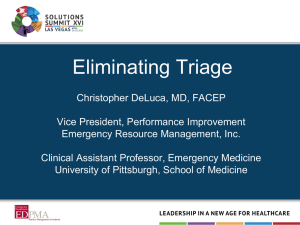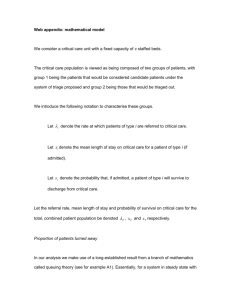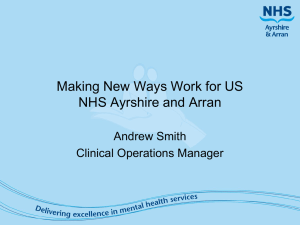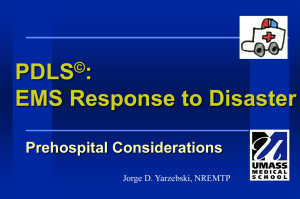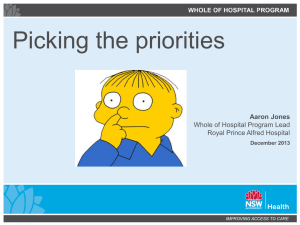Ebola Triage and Isolation Exercise for Hospital ED
advertisement
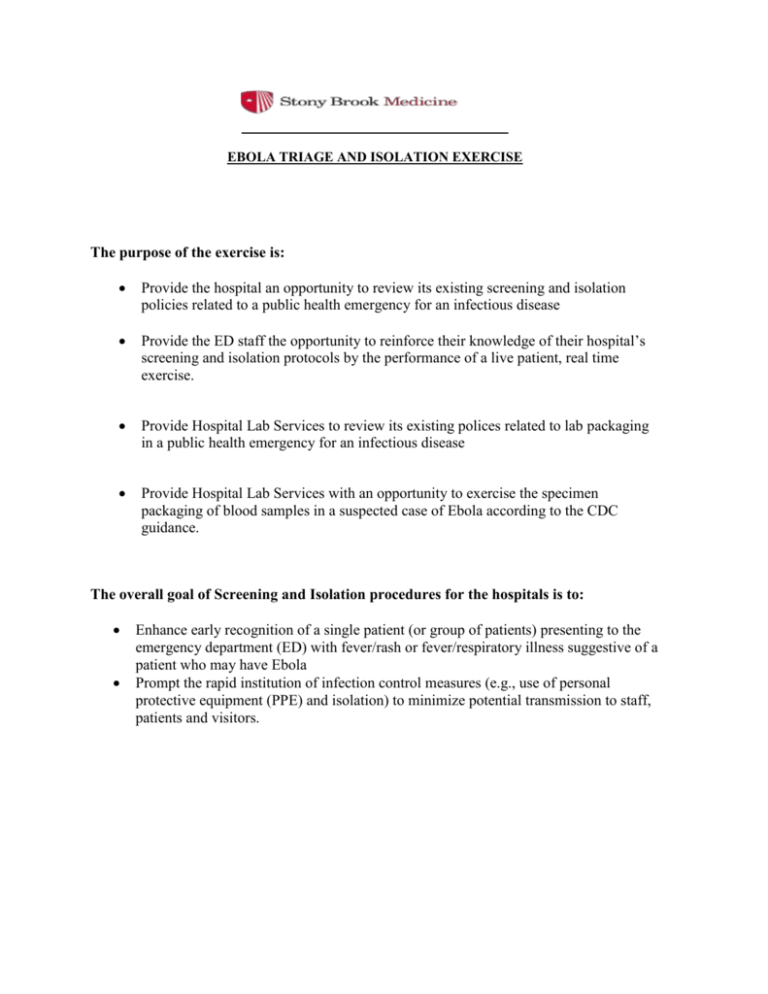
EBOLA TRIAGE AND ISOLATION EXERCISE The purpose of the exercise is: Provide the hospital an opportunity to review its existing screening and isolation policies related to a public health emergency for an infectious disease Provide the ED staff the opportunity to reinforce their knowledge of their hospital’s screening and isolation protocols by the performance of a live patient, real time exercise. Provide Hospital Lab Services to review its existing polices related to lab packaging in a public health emergency for an infectious disease Provide Hospital Lab Services with an opportunity to exercise the specimen packaging of blood samples in a suspected case of Ebola according to the CDC guidance. The overall goal of Screening and Isolation procedures for the hospitals is to: Enhance early recognition of a single patient (or group of patients) presenting to the emergency department (ED) with fever/rash or fever/respiratory illness suggestive of a patient who may have Ebola Prompt the rapid institution of infection control measures (e.g., use of personal protective equipment (PPE) and isolation) to minimize potential transmission to staff, patients and visitors. Exercise Roles: Exercise Coordinator Exercise Controller Triage Evaluator Lab Evaluator Mock Patient ED Staff Lab Staff Infection Control Staff The mock patient presents to the ED, unannounced. The patient offers only the chief complaint and history as described in the pre-constructed script. No other information is offered unless requested. The ED and triage staff process the patient according to the hospital’s screening and isolation protocol, including the use of personal protective equipment (PPE). Lab samples will be obtained without venipuncture using colored liquid for specimen vials. The patient and evaluators note all aspects of the procedure during the exercise. They log their observations on the exercise evaluation form after the exercise is complete. A hot wash is conducted following the exercise. Subsequently the drill coordinator coordinates the development of an exercise improvement plan. Exercise Planning Meeting 1. Drill Coordinator a. Drill should be unannounced. b. Drill is considered to start as soon as patient and observer staff walk in through ED entrance from outside and considered to end as soon as ED medical personnel completes evaluation of patient and identifies disposition of patient. c. Drill Coordinator should identify points at which drill would require intervention or need to be ended prematurely. i. For example, if specialist called to see patient (e.g., infectious disease consult, dermatology consult), then either patient should be instructed to intervene with note saying that this is a drill and to continue drill or drill should be ended. d. Medical record needs to be voided after the drill is completed. A letter can be drafted by NYSDOH HSEP to confirm that this is part of a drill. This should follow hospital protocol for voiding of record. 2. Evaluator a. This person should be someone naturally present in ED at time of drill and his/her presence should not tip the ED staff to the drill. 3. Patient Emergency Management Department 2014 a. The patient should be instructed to ignore the signs that say to self-report and/or to put on mask or perform hand hygiene. b. When temperature is being taken, patient should state that he/she just took Tylenol 60 minutes before they came in to the ED. c. Patient should be instructed to refuse chest radiographs (CXR), labs, or any invasive procedure. Critical Actions for Screening/Isolation Exercise The following are the critical actions that should be observed during the drill for the hospital to be considered to be in compliance with the Communicable Disease Triage Protocol: 1. Clearly visible signage, surgical masks, and alcohol hand hygiene products at entrance 2. Triage/screening staff ask potential patients questions about symptoms and risk factors 3. Patients with positive communicable disease triage screen are rapidly and appropriately isolated a. If not immediately placed in isolation, patient is separated from others in waiting area b. If in isolation room, appropriate infection control signage posted outside door 4. Patient instructed/educated about isolation measures 5. Time and type of isolation measure documented in chart 6. Patient given a surgical mask, if not already wearing one, or if not in airborne infection isolation room 7. Staff coming in contact with patient wears appropriate PPE 8. Triage staff notifies appropriate staff, who then notify Infection Control and/or ID physician. Emergency Management Department 2014 Script for Patient with Fever/Respiratory Symptoms Volunteer Patient: Thank you for participating. Remember, at no time do we want you to feel uncomfortable so we ask that you do the following: Use a fake DOB, SSN, Address, Phone number. If you want to fake your name, that is fine, but just be able to remember it. Tell the Registrar that you do have health insurance but that you left your wallet and cards at home (as you were brought to the hospital by your friend) Refuse all blood draws, x-rays or invasive procedure. At any time, you can reach out to the trusted agent to stop the drill. Chief Complaint: “I’ve been having 4–5 days of fever and I am having a nausea, vomiting and diarrhea” History: 4–5 days of fever (to 101°F), chills, cough, fatigue, and nausea, vomiting and diarrhea. Other generalized muscle aches. No rash. Just took 2 Tylenol Extra Strength for fever and muscle aches an hour ago. Other Information to Offer, IF ASKED: Allergies: None Medications: Tylenol Past Medical History: None. No history of asthma, diabetes, lung disease. Social History: Spouse/partner also ill, became ill about the same time. Two children OK Came back from Guinea1 week ago. Traveled with church group. Did NOT come in contact with ill persons. Do not work in healthcare No contact with ill persons, except spouse Improvise other information as needed. Emergency Management Department 2014 Synopsis on Screening/Isolation Protocol Communicable Disease Triage Screen Screening should include asking all patients with fever about the presence of respiratory symptoms (cough or shortness of breath) and rash symptoms, as well as epidemiologic risk factors, such as recent travel. Emergency Management Department 2014 Screening and Isolation Evaluation Form Name of Hospital: ______________________ Date: ______________________ Circle one of the following: HSEP/RRC Observer/Evaluator :_________________________ Signature Point of Entry 1. Time the patient arrived at ED AM / PM 2. Which of the following signs are posted in the ED waiting area/entrance way? Sign in multiple languages? Sign in multiple languages? Sign in multiple languages? Sign in multiple languages? ash/resp Sign in multiple languages? 3. If there are any of the signage above, is it clearly visible? 4. Are surgical masks available to the public in the ED waiting area/entrance? No 5. Are surgical masks visible to the public in the ED waiting area/entrance? No 6. Are tissues available to the public in the ED w 7. Are alcohol hand hygiene products/sink available for patient use in the ED waiting area/entrance? 8. Upon arrival, patient is instructed to go to: (check off appropriate answer) 9. Upon arrival, with whom did the patient first come in contact? (Check off appropriate answer) Time saw first contact with above: AM / PM 10. Did initial contact give patient a mask? 11. Did initial contact tell patient to perform hand hygiene after coughing or after coming in contact with respiratory secretions or rash? Emergency Management Department 2014 Circle one of the following: HSEP/RRC OR Hospital Evaluator _______Signature :________________________ Triage 12. Did patient see the triage nurse? 13. Time the patient saw triage nurse AM / PM FOR PATIENT or DOH Evaluator or Hospital Evaluator: 14. Did triage ask patient about: Symptoms? Type of work? 15. Did triage give patient a mask to wear? mask 16. Did triage tell patient to wear mask at all times? (except when in isolation room) 17. Did triage show patient how to put on a mask? on correctly 18. Did triage tell patient to perform hand hygiene after coughing or after coming in contact with respiratory secretions or rash? 19. Did triage show patient how to use hand hygiene products? 20. What was patient’s disposition after triage? waiting area (Go to question 21) ED evaluation area (Go to question 22) to segregated waiting area (Go to question 21) 21. If patient sent back into waiting area after triage: a. Time patient sent back to waiting area b. Time patient sent back into waiting area documented in chart? c. Patient kept at least 3 feet away from other patients? d. Patient was given tissue? e. Patient instructed not to wander around? f. Does the chart/medical record indicate that patient is to be isolated AM / PM g. Time patient was sent to ED evaluation area______________ AM / PM (Go to Question 22 when patient is subsequently sent to ED evaluation area) Emergency Management Department 2014 22. When patient sent to ED evaluation area, where was patient placed? Airborne Infection Isolation Room (AIIR, negative pressure room) Private room with door Portable isolation chambers Other: a. Time patient sent to ED evaluation area AM / PM b. Time documented in the chart? c. Type of isolation documented? d. Signage outside room about isolation precaution? e. Appropriate PPE outside the door? f. Hand hygiene products or a sink with water/soap at doorway/anteroom? g. Waste receptacle at doorway/anteroom? For Patient or Hospital Evaluator (or HSEP/RRC Evaluator if able to go to ED) 23. Did the health care provider wear PPE? What was worn by nurse? What was worn by MD/PA/NP? 24. Was PPE donned and doffed properly? What was donned and doffed properly by nurse? What was donned and doffed properly by MD/PA/NP? 25. Did provider use hand hygiene product/wash hands after the visit? 26. Was the ED staff presented with the medium for specimen vials? Yes 27. Were the specimens transported to the lab according to protocol? Yes Time patient seen by MD/PA/NP: Time drill called off: Emergency Management Department 2014 No No AM / PM AM / PM Factors that would STOP the Drill Patient should refuse all blood draws and x-rays. If provider insists on having this done, patient/trusted agent should stop drill, announce that it is a drill, and move on to the hot wash. If an ID/Pulmonary/Dermatology/Medical consult is called, then Patient/Trusted Agent should stop drill. If patient is held in waiting area for more than 30 minutes before being seen (this time can be agreed upon during pre-drill meeting) If patient is in room but not seen for more than 30 minutes. If patient will be taking up a bed or isolation room when a “TRUE” patient needs that bed or isolation room, then trusted agent should stop drill, announce drill, and move on with drill but in different location in ED. Emergency Management Department 2014 Additional Comments Strengths: Opportunities for Improvement: Challenges: Recommendations: Comments: _______________________ HOSPITAL, NEW YORK SCREENING AND ISOLATION EXERCISE IMPROVEMENT PLAN 1. Task/Objective Recommendations From Exercise Evaluation Tool Issue(s) observed in this component of the Exercise Time patient: arrived at ED to time seen by triage seen by triage to seen in ED evaluation area. 2. Signage posted in the ED waiting area/entrance. 3. Signage in multiple languages. 4. Signage clearly visible. 5. Surgical/procedure masks available to the public in the ED waiting area/entrance. 6. Surgical/procedure masks visible to the public in the ED waiting area/entrance. 7. Alcohol hand hygiene products/sink available for patient use in the ED waiting area/entrance. 8. Alcohol hand hygiene products/sink visible to the public in the ED waiting area/entrance. 9. Tissue is available for patient use in ED waiting area/entrance. 10. Patient is instructed to go to______ on arrival. Improvement Action Actions to be taken to address issue(s) raised in this component of the exercise Responsible Party Completion Date Task/Objective Recommendations From Exercise Evaluation Tool Issue(s) observed in this component of the Exercise 11. Patient given mask by initial contact. 12. Initial contact instructed patient to perform hand hygiene after coughing or after coming in contact with respiratory secretions or rash. 13. Patient seen by triage staff. 14. Triage asked patient about; symptoms, travel history, occupation, contact with ill person. 15. Triage gave patient a mask to wear. 16. Triage instructed patient to wear mask at all times (except when in isolation room). 17. Triage demonstrated to patient how to put on a mask. 18. Triage instructed patient to perform hand hygiene after coughing or after coming in contact with respiratory secretions or rash. 19. Triage demonstrated to patient how to use hand hygiene products. 20. Patient was sent to __________after triage. 21. Patient was sent back into waiting area after triage. 22. Patient was sent to ED evaluation area after triage. 23. PPE worn by the health care provider(s). Emergency Management Department 2014 Improvement Action Actions to be taken to address issue(s) raised in this component of the exercise Responsible Party Completion Date Task/Objective Recommendations From Exercise Evaluation Tool Issue(s) observed in this component of the Exercise 24. PPE was donned and doffed properly? 25. Health care provider(s) used hand hygiene product/wash hands after the visit? 26. Specimens collected and transported to lab. 27. Specimen processed in lab according to protocol. Emergency Management Department 2014 Improvement Action Actions to be taken to address issue(s) raised in this component of the exercise Responsible Party Completion Date Emergency Management Department 2014


